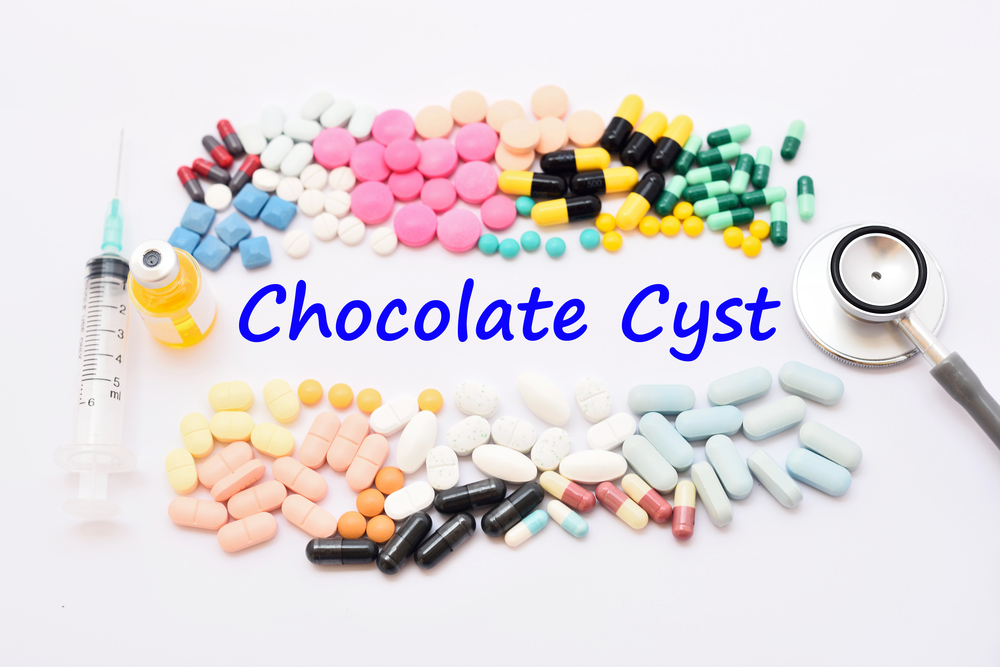What Is Chocolate Cyst (Ovarian Endometrioma) ?

A chocolate cyst, also known as an ovarian endometrioma, is a fluid-filled sac that forms on the ovary because of endometriosis. Endometriosis is when the endometrium grows outside the uterus, causing pain and discomfort. Chocolate cysts are so named because of their dark, reddish-brown appearance due to the presence of old blood. Understanding and addressing chocolate cysts is crucial, as they can cause severe pain, impact fertility, and reduce the quality of life for women affected by them.
Chocolate Cyst Causes
Chocolate cyst is caused due to endometriosis. When endometrial tissue grows on the ovaries, it can cause inflammation, scarring, and the formation of cysts filled with old blood. We do not know the actual cause of endometriosis, but hormonal factors are believed to contribute to its development.
Hormones, particularly oestrogen, are thought to promote the growth of endometrial tissue outside the uterus.
There is also evidence suggesting that genetic predisposition and environmental influences may also be responsible for causing chocolate cysts.
Chocolate Cyst Symptoms
Chocolate cyst symptoms can vary significantly depending on the size, location, and severity of the cysts. Some of the most common chocolate cyst symptoms include:
- Pelvic pain: Pelvic pain is a common symptom of chocolate cysts. The pain can be dull, sharp, or cramp-like and may worsen during menstruation, bowel movements, or physical activity.
- Painful periods (dysmenorrhea): Women with chocolate cysts may experience severe pain during their menstrual periods. This pain can be more intense than typical menstrual cramps and may last longer than the duration of the period.
- Pain during intercourse (dyspareunia): Pain during or after sexual intercourse is another common symptom of chocolate cysts. The pain may be localized or diffuse, depending on the location of the cysts.
- Heavy or irregular menstrual bleeding: Chocolate cysts can cause heavy or irregular periods, with menstrual cycles being longer or shorter than usual.
Less common symptoms of chocolate cysts include infertility, fatigue, bloating, and gastrointestinal issues. The severity and presentation of these symptoms can be influenced by various factors such as cyst size, and the individual's pain tolerance.
Diagnosis of Chocolate Cysts
Diagnosing chocolate cysts typically begins with a physical examination. Imaging studies such as ultrasound or magnetic resonance imaging (MRI) can help visualize the cysts and determine their size and severity. However, a definitive diagnosis can only be made through laparoscopy, a minimally invasive surgical procedure that allows a physician to directly examine the pelvic organs and collect tissue samples for further analysis.
Treatment Options for Chocolate Cysts
Treatment options for chocolate cysts vary depending on the severity of symptoms, the size of the cysts, and the patient's age and fertility goals. Some treatment options include:
1. Medical management: In some cases, doctors may recommend medical management to alleviate pain and discomfort. This approach is the best chocolate cyst treatment without injury. It may involve pain relief medications such as nonsteroidal anti-inflammatory drugs (NSAIDs) or hormonal therapy, including birth control pills, progesterone-only medications, or gonadotropin-releasing hormone (GnRH) agonists. Hormonal therapy can help regulate menstrual cycles and suppress the growth of endometrial tissue, thus reducing the size and symptoms of chocolate cysts.
2. Surgical interventions: When medical management is not responding or the cysts are large, causing severe symptoms or impacting fertility, surgical intervention may be necessary. Surgical options include:
-
- Cystectomy: This procedure involves the removal of the cyst while preserving the healthy ovarian tissue. It is the preferred option when fertility preservation is a concern.
- Oophorectomy: In this procedure, the surgeon removes the entire ovary affected by the cyst. This option is usually reserved for cases where the ovary is severely damaged or if there is a risk of cancer.
- Keyhole Surgery: Surgery for chocolate cysts is performed laparoscopically (keyhole surgery). It has minimal post-operative pain and quick recovery.
3. Alternative and complementary treatments: Some women may explore alternative chocolate cyst treatments without injury in conjunction with conventional medical care to help manage symptoms and improve their overall well-being. These treatments may include:
-
- Diet and lifestyle modifications: Adopting a healthy diet rich in anti-inflammatory foods, maintaining a healthy weight, and engaging in regular exercise can help keep symptoms at bay and improve overall health.
- Acupuncture and herbal medicine: Some women have reported relief from endometriosis and chocolate cyst symptoms through acupuncture and the use of herbal supplements. However, we need more research to understand their efficacy, and it is essential to consult with a healthcare professional before starting any alternative treatments.
4. Fertility preservation and treatment options: Women with chocolate cysts who are trying to conceive may require fertility treatments like IVF or intrauterine insemination IUI. In some cases, fertility preservation methods like egg freezing may be recommended before undergoing surgery for chocolate cysts.
Conclusion
Early detection and diagnosis of chocolate cysts are vital for managing symptoms, preserving fertility, and improving the quality of life for affected women. If you suspect you may have a chocolate cyst or are experiencing symptoms associated with this condition, it is essential to seek appropriate medical advice and treatment.
If you think you might be at risk of chocolate cysts, consult a gynecologist immediately!






